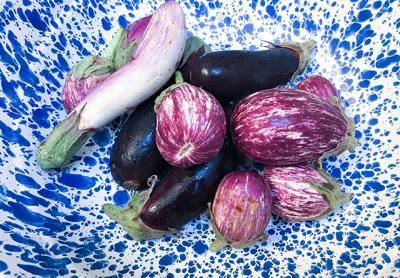Seasons by the Sea: Endless Eggplant Possibilities

When eggplants were taken from India to England long ago, they were considered an ornamental plant. They are the only major vegetable of the nightshade family (tomatoes, squash, tobacco, peppers, potatoes) that came from the Old World. According to Harold McGee in his book “On Food and Cooking: The Science and Lore of the Kitchen,” “an early ancestor may have floated from Africa to India or Southeast Asia where it was domesticated.” Eggplant was being eaten in Italy by the 15th century and in France by the 18th.
If you’ve ever seen an eggplant plant, you might appreciate why it was a prized ornamental. It has furry, soft gray-green leaves with purple veins. The single flowers form deep violet stars, similar to potato flowers. But in the olden days the somewhat bitter fruit was considered poisonous and thought to cause leprosy, insanity, cancer, and a grumpy personality. I kid you not!
Eggplants can be tricky to store and prepare. Because they are a subtropical plant, they do not appreciate the super-cold temperatures of our modern refrigeration. They are best kept for no more than a day or two out on the counter (although they will lose some moisture this way), or refrigerated, wrapped well, in the least cold part of your fridge. Fifty degrees is the ideal storage temperature. The bitterness of some eggplants comes from alkaloids and becomes more pronounced with age. In other words, those big bulbous Black Beauties you buy at the supermarket are the most likely to have some bitterness. So your best bet is to grow your own, or sample some of the freshly picked eggplants at local farm stands.
When it comes to cooking, eggplants are notorious for their spongy texture and ability to soak up gobs of oil. As a matter of fact, an ancient Turkish recipe is called “imam bagildi,” or “the priest fainted,” because the priest got the vapors after he found out how much oil his wife used to make the dish.
Some people believe that salting slices of eggplant draws out the bitterness and reduces the eggplant’s ability to absorb a lot of oil when frying. Mr. McGee doesn’t go for this theory, and says the salting only reduces our perception of the alkaloids and the bulk of the cell fluids remain. Some also believe there is a difference between male and female eggplants, but it really is just age and cold storage that produce bitterness (unless it is a particular, intentionally bitter variety of eggplant, such as those favored in India and Asia).
As far as their spongy ability to absorb oil, there is a simple solution: Don’t fry them. Brush the slices with as much oil as you wish to use, season, broil or roast them, and then proceed with your recipe for eggplant Parmesan or whatever.
The bright side of this absorbent quality and the eggplant’s rather bland but meaty personality is its compatibility with so many other flavors: garlic, tomato, and cheese for Italian dishes, scallions, miso, sesame oil, and pork for Asian dishes, yogurt, pomegranate seeds, and za’atar for Middle Eastern recipes. In India, Iran, and Afghanistan they are pickled and turned into chutneys.
Eggplants are low in calories but have plenty of fiber, potassium, manganese, copper, vitamins B2 and B6, folate, magnesium, niacin, and phytonutrients.
There are so many varieties of eggplants available right now, and so many ways to cook them, you should experiment. Some types you may come across are Caspar, a white, six-inch-long fruit with delicate flavor; Listada de Gandia, a beautiful oval shape with light purple and white stripes; Thai green, a long slender 12-inch fruit with white flesh and green skin, and Rosa Bianca, a teardrop-shaped white eggplant with a mild flavor. And then, of course, there’s the Black Beauty, that humongous truncheon of the supermarket.
When choosing eggplants, make sure they are firm, not puckery, and feel heavy. Sometimes those grocery store eggplants are as light as Styrofoam.
Small, thin eggplants can be prepared by simply throwing them on the grill. The larger fruits can be roasted, steamed, grilled, cubed, mashed — the possibilities are endless. Here are some recipes to get you past “Eggplant 101.”
Click for recipes
